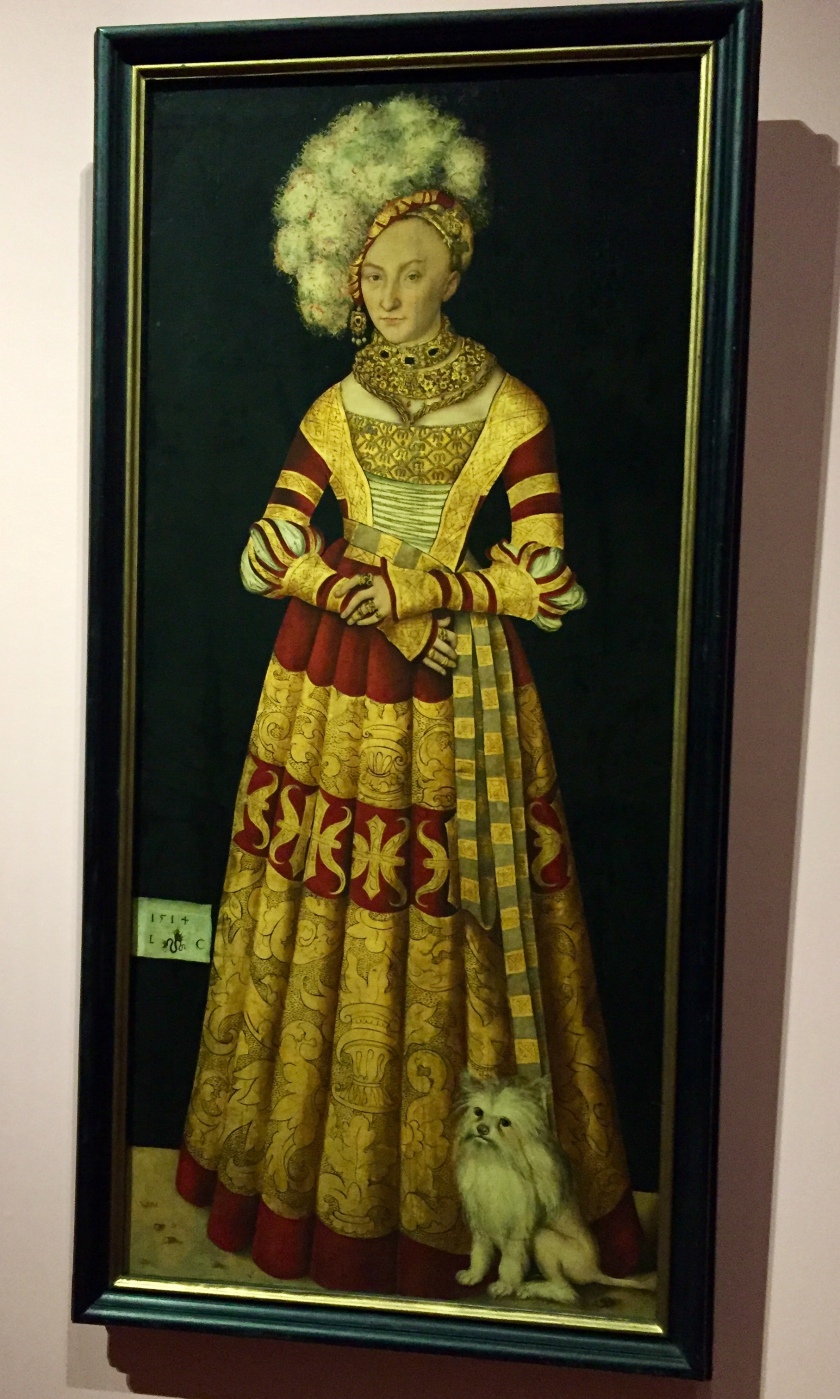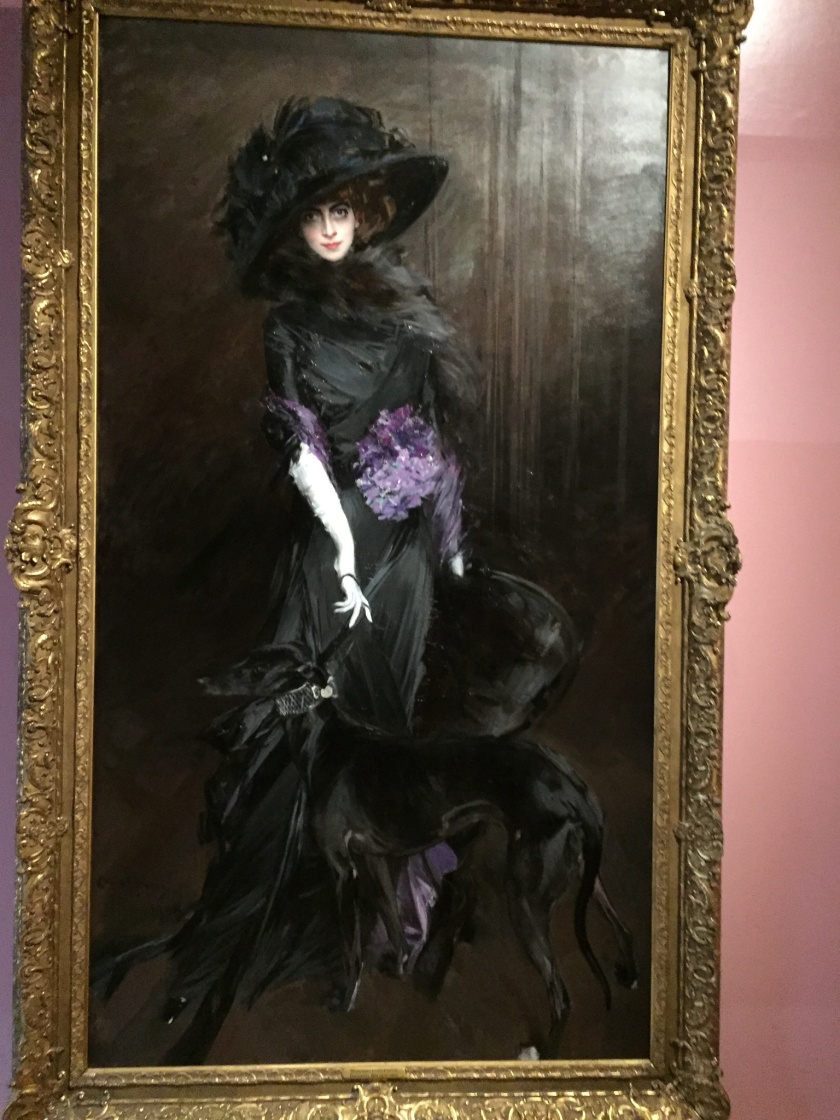Having been invited to Amsterdam for the birthday of a dear friend, a group of us were lucky enough to visit a temporary exhibition at the Rijksmuseum entitled High Society.

The exhibition features a collection of 35 full-length, life-size portraits of monarchs, aristocrats and rich citizens, by great masters in art history. It spans four centuries (from early 16th to the start of the 20th), and is styled as a party—featuring power, wealth, and massive egos. Because of the time and expense involved in painting such large canvases, this was a form of portraiture reserved for royal and noble subjects and, in later years, for what would now be known as ‘the one percent’.
It is also a timeless, fascinating, international fashion show, since people dressed in their best finery for the occasion. The paintings are full of symbols of the subjects’ wealth and power. Cloth of gold, lace, embroidery, large and intricate jewelry. There are also lots of accessories and plenty of dogs—lap dogs to show pampered luxury, fierce hunting dogs as symbols of strength.

See, above and below, how the painter Lucas Cranach (c.1472-1553) portrayed, for the first time in Northern Europe, a couple standing, life-size, and full length. They were Catherine of Mecklenburg (1487-1561) and Henri the Pious, Duke of Saxony (1473-1541), and the painting was commissioned in honor of their marriage in 1512.

He wears a wreath of red and white carnations to show he is a groom and, surprisingly, he’s neither clean-shaven nor bearded, but sports a very modern stubble.
Then there are Rembrandt’s wedding portraits of Marten Soolmans and Oopjen Coppit – his only life-size, standing, full-length portraits. Painted in 1634, they were a joint 2016 purchase by the Kingdom of the Netherlands and the Republic of France from the Rothschild collection, and they have just been restored. They are not as handsome as the previous couple, but their wedding black is accessorized with the most intricate lace collars and matching flower belt buckles.

It must be noted that, at the time, the wearing of black showed ostentation, not restraint: black was the most expensive material, had to be laboriously dyed and was difficult to upkeep. It was therefore a symbol of status which could, moreover, show off silver buckles and lacework to advantage.

The most powerful man of Europe, Charles V, Holy Roman Emperor, (1500-1558), had himself painted life-size by Jacob Seisenegger (1505-1567), showing just how important this type of portrait had become. Note the very wide shoulders, another symbol of strength, and the hunting dog.

An austere and powerful portrait, of Don Pedro di Barberana y Aparregui (1579-1649) by Velázquez (1599-1660). Don Pedro moved in powerful circles in 17th-century Spain, was comptroller of the royal treasury and sat on the King’s secret council. Note the plain background, contrasting with others that are richly decorated, and the tip of the sword lifting his coat at the back.

In a looser mode, the enchanting portraits, by Veronese, of Count Iseppo da Porto (c.1500-1580) with his son Leonida. The Count was one of the most influential figures in the town of Vicenza in the 16th century.

And that of his wife, Countess Livia da Porto Thiene, also descended from a noble family, and her daughter, Deidamia.
They are portrayed in ‘everyday’ clothes, which, although luxurious, are not too showy. It is rare these portraits can be seen together, since, sadly, his is in the Uffizi Gallery, while hers is in the Art Museum in Baltimore. A great shame, since being displayed next to each other greatly enhances the emotional import.

Moving on to more recent times, the portrait, by the English artist Gainsborough (1727-1788) of the beautiful Mary, Countess Howe dressed in what would have been the height of fashion in the mid-1700s. Her pale complexion is enhanced by the black ribbon on her wrist and her arsenal of expensive accessories also attest to her aristocratic status. Gainsborough only yearned to paint landscapes, but these would not earn him a living, so he was obliged to paint the local gentry, moving to another town with all his family in search of more clients, once he had finished one lot.

This portrait by John Singer Sargent (1856-1925) was a rare treat, as it is domiciled in Los Angeles, where women are said to swoon before it. It depicts the exceedingly handsome Dr. Samuel-Jean Pozzi (1846-1918), who was the founder of modern French gynaecology and an incorrigible womanizer. Sargent, an American artist who moved to Europe, appropriately painted him in a scarlet dressing gown and embroidered satin slippers. Pozzi was killed by one of his clients, a man whose impotence he had failed to cure. He nevertheless had a long and distinguished medical career, and consorted with many creative people, such as Sara Bernhardt, who was briefly his lover and remained a lifelong friend, and Marcel Proust.

Giovanni Baldini’s Marchesa Luisa Casati with a Greyhound (1908) catches its subject in what is, for Casati, a relatively understated outfit: she once wore a dress of lightbulbs wired up to a generator. She was once described as the Lady Gaga of her day.
The card next to the painting says: Six feet tall and thin as a rake, and with bleached skin, heavily made up eyes and hair dyed either a fiery red or emerald green, Luisa Casati’s appearance was unforgettable. At the many legendary parties thrown by the flamboyant and eccentric marchesa the champagne flowed freely and there was no shortage of cocaine and opium. Boldini painted Casati wearing haute couture and accompanied by her favourite greyhound with his characteristic, ‘slashing’ brushstrokes.

A last highlight was the portrait, by Kees van Dongen (1877-1968), of Anna, Comtesse de Noailles (1876-1933), a writer and leading figure of Parisian society. The portrait was considered shocking, if not offensive, at the time, because of the plunging neckline revealing a hint of nipple, and the fact that she irreverently wears the ribbon of the Legion d’Honneur (a great honor conferred by the state) as a choker around her neck.
It was a rare treat to see these portraits assembled in one place—and fascinating to compare the mores and fashion of each era. To finish, I wanted to share a video of the Museum’s wonderful Shylights, a light installation created, out of silk, by Studio Drift.
If you click on the video, it will magically right itself, for some mysterious reason.
